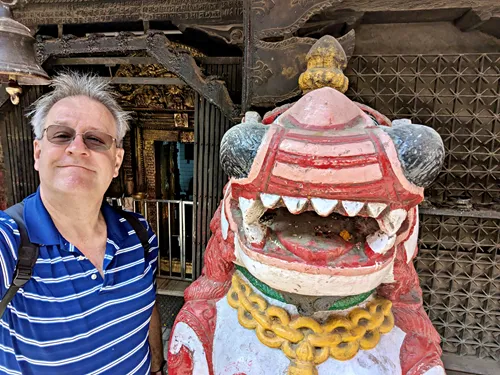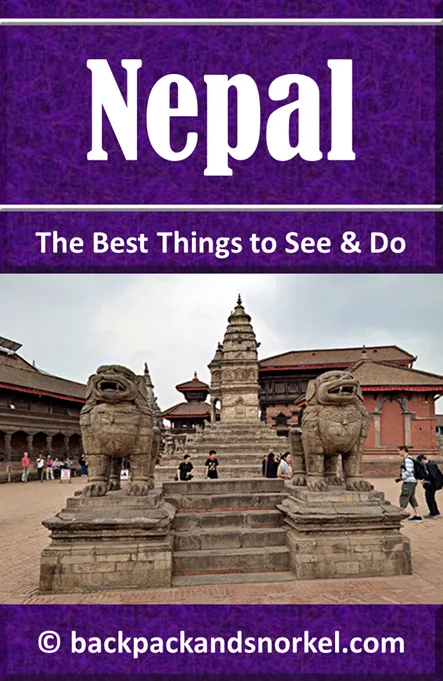Nardevi Temple: A Journey into Kathmandu's Ancient Cultural Heart - Nepal Purple Travel Guide
(map, reviews)
This is Premium Content! To access it, please download our
Backpack and Snorkel Purple Travel GuideThe name ‘Nardevi’ is derived from ‘Nar’, meaning human, and ‘Devi’, meaning goddess, which together signify ‘Goddess of Mankind’ or ‘Protector of People’. Nardevi is a fierce manifestation of the goddess Durga or Kali, and worshipped for her power to ward off evil, and to ensure the safety of the community.
According to local legend, the goddess appeared in a vision, prompting the establishment of her shrine at the current site to safeguard the area from misfortune and disease. Her role as a guardian deity is deeply respected in Kathmandu’s historic quarters.



Here at Backpack and Snorkel Travel Guides, we typically promote self-guided walking tours.
But we realize that not everybody likes to walk by themselves in a foreign city. So, just in case that you rather go with ab guide: NO PROBLEM! Please see the Viator tours below.
free GuruWalk tours
paid Viator tours
Architecture and Cultural Significance of Nardevi Temple
The Nardevi Temple features a traditional Newar-style pagoda structure with a distinct multi-tiered roof, finely carved wooden struts, and metal ornamentation. Inside, the temple houses a sacred image of the goddess, which is hidden from public view most of the time, and only revealed during special rituals and festivals.
The temple is especially important to the Kumari tradition, as the Living Goddess of Kathmandu visits Nardevi Temple during specific festivals, further enhancing the temple’s spiritual weight and cultural relevance.
There is a myth that is embedded in local traditions and that has been cited by several historical chronicles about the founding and early traditions of the Nardevi Temple.
Legend has it that a king from neighboring Patan, venturing into the wilds of what was then Kantipur (modern Kathmandu) on a hunting expedition, found himself unexpectedly lost. Near the area now known as Kilagal, danger struck – a wild elephant, charging and relentless, forced the king to flee. His desperate escape led him near the present-day site of the Nardevi Temple, where he sought refuge within the embrace of a massive tree. Exhaustion and fear took their toll, and the king lost consciousness.
Upon waking, the story recounts a profound encounter. The goddess Swetakali (translated: White Kali; Swetakali is a manifestation of the white (calm and benevolent) side of the powerful goddess Kali, the bestower of life and protection) herself is said to have appeared before him, her presence a beacon of hope. Her words, a simple yet powerful bestowal of life, echoed, 'You may live'. Deeply moved and grateful for this divine intervention, the king returned to his kingdom in Patan. However, the memory of his encounter lingered, compelling him to commemorate the life-saving grace he had received. Thus, Nardevi Temple was erected on the very spot where he had found sanctuary.
Interestingly, the influence of this sacred site extended beyond its initial founding. Later, two kings from the powerful kingdom of Bhaktapur are also said to have experienced visions of the same benevolent goddess. These encounters solidified the temple's importance and inspired the Bhaktapur rulers to actively contribute to its preservation. They initiated traditions that continue to this day, including the ritualistic lighting of ghee lamps as an offering and the significant act of sacrificing a sheep within the temple grounds. This specific ritual is uniquely carried out by the Kumale potters from the nearby town of Thimi, a tradition passed down through generations as their way of honoring the goddess.
Adding another layer to this enduring story is the local conviction surrounding the goddess's original abode, referred to as 'Byachen'. Situated in the vicinity of the temple, this is believed to be the sacred repository where the goddess’ ornaments and clothing are carefully safeguarded, a tangible link to the divine presence that continues to watch over the community.
History of Nardevi Temple
The temple is believed to have been established in the ninth century by the Thakuri ruler Gunakamadeva (949 to 994 AD), who founded Kathmandu (then known as Kantipur).
Nardevi Temple's Role in Rituals and Festivals
Nardevi Temple is a key location during Indra Jatra, one of Kathmandu’s grandest street festivals, which lasts 8 days and is typically held in September, but the exact date varies, as it is timed according to the lunar calendar. The festival is primarily dedicated to Lord Indra, the Hindu god of rain and king of heaven, and its purpose is to offer thanks for the monsoon rains that are crucial for agriculture and a good harvest. One of the main attractions is the Kumari Jatra, the chariot procession of the Living Goddess Kumari. Kumari, a young Newar girl considered the embodiment of the goddess Taleju, is taken out in a beautifully decorated chariot through the ancient streets of Kathmandu. She is accompanied by chariots carrying representatives of Ganesh and Bhairav.
The parade has stops at various temples, including Nardevi, to pay homage. The temple also hosts regular pujas (rituals), particularly by locals seeking the goddess’ protection or blessings for health and prosperity.
Visiting Nardevi Temple
When you visit the temple, you will not be able to enter, but you can peek through the front door, and pose for photos with the 2 colorfully painted mythical figures on each side of the door.
Etiquette: Respect the barriers and do not reach over them into the temple.
Back to your self-guided tour
Author: Rudy at Backpack and Snorkel
Bio: Owner of Backpack and Snorkel Travel Guides. We create in-depth guides to help you plan unforgettable vacations around the world.
Other popular Purple Travel Guides you may be interested in:
Like this Backpack and Snorkel Purple Travel Guide? Pin these for later:





